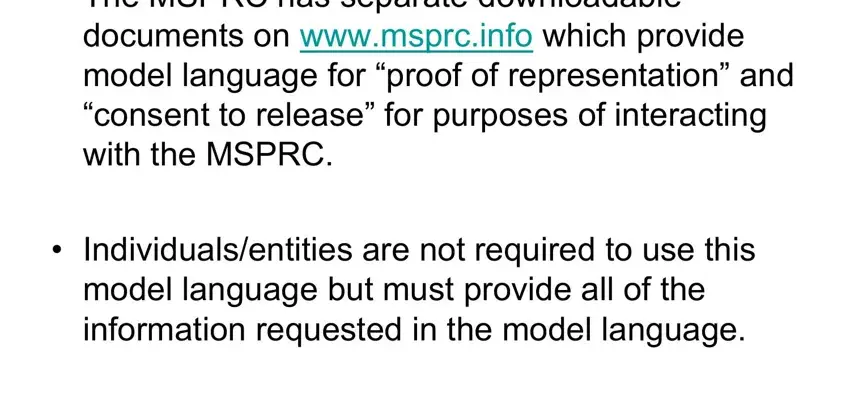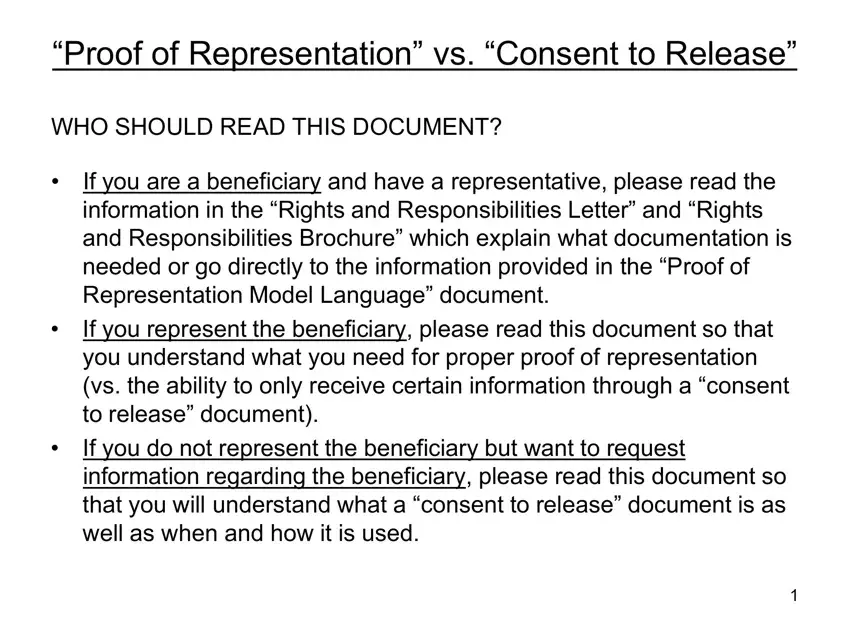“Proof of Representation” vs. “Consent to Release”
WHO SHOULD READ THIS DOCUMENT?
•If you are a beneficiary and have a representative, please read the information in the “Rights and Responsibilities Letter” and “Rights and Responsibilities Brochure” which explain what documentation is needed or go directly to the information provided in the “Proof of Representation Model Language” document.
•If you represent the beneficiary, please read this document so that
you understand what you need for proper proof of representation
(vs. the ability to only receive certain information through a “consent to release” document).
•If you do not represent the beneficiary but want to request
information regarding the beneficiary, please read this document so that you will understand what a “consent to release” document is as well as when and how it is used.
Rules and Model Language
for
“Proof of Representation” vs. “Consent to Release”
for
Medicare Secondary Payer
Liability Insurance (Including Self-Insurance),
No-Fault Insurance, or Workers’ Compensation
General
•Pursuant to the Privacy Act, Medicare does not release information from a beneficiary’s records without appropriate authorization to do so.
•For beneficiaries who have filed a claim for liability insurance (including self-insurance), no-fault insurance, or workers’
compensation, this typically means that the MSPRC will receive either a “proof of representation” document signed by the beneficiary and the beneficiary’s representative or a “consent to release” document signed by the beneficiary. (See page 12. Medicare may
provide conditional payment information to no-fault insurers or workers’ compensation carriers without a “consent to release” document.)
“Consent to Release” vs. “Proof of Representation” –
What’s the Difference?
•Proof of Representation -- The beneficiary has authorized the individual or entity (including an attorney) to act on the beneficiary’s behalf. The representative has no independent standing, but may receive or submit information/requests on behalf of the beneficiary, including responding to requests from the MSPRC, receiving a copy of the recovery demand letter if Medicare has a recovery claim, and
filing an appeal (if appropriate) when that beneficiary is involved in a liability, workers’ compensation, or auto/no-fault situation.
Under these circumstances, the exchange of information is a two way street. The individual or entity may provide necessary
information to or interact with the MSPRC, on behalf of the beneficiary, in order to resolve Medicare’s Recovery Claim.
“Consent to Release” vs. “Proof of Representation” –
What’s the Difference?
•Consent to Release – The beneficiary has authorized an individual or entity to receive certain information from the MSPRC for a limited period of time. The release does not give the individual or entity the authority to act on behalf of the beneficiary.
Under these circumstances, the exchange of information is a one- way street. The beneficiary has authorized the MSPRC to provide privacy protected data to the specified individual/entity, BUT this does not authorize the individual/entity requesting information to act on behalf of/make decisions on behalf of the beneficiary.
Proof of Representation –
What is required?
The following pages will address:
•Beneficiary non-attorney representatives.
•Beneficiary attorney representatives ( including third part lien negotiation entities).
•Beneficiary guardians, conservators, power of attorney, Medicare representative payees.
•Situations where the beneficiary’s representative (representative payee, conservator, guardian, power of attorney) has hired an attorney or the beneficiary attorney has referred the case to another attorney.
•Deceased beneficiaries.
•Workers’ Compensation or No-Fault Insurance vs. Liability Insurance (Including Self-Insurance).
•Agents for insurers or workers’ compensation carriers.
Proof of Representation –
What is required? (continued)
Beneficiary non-attorney representatives.
1.The beneficiary must:
•Provide his/her name as shown on his/her Medicare card,
•Provide his/her Medicare Health Insurance Claim Number (HICN)(the number on the Medicare card),
•Appoint the representative in writing,
•Specify the following information for the representative: name, type of representative, firm/company name (if applicable), address, telephone number,
•Sign and date the appointment,
2.The representative must sign and date the document to show that he/she has agreed to represent the beneficiary.
7
Proof of Representation –
What is required? (continued)
Beneficiary attorney representatives may submit their retainer
agreement with the beneficiary if:
•The retainer agreement is on attorney letterhead or accompanied by a cover note on letterhead,
•The retainer agreement is signed by the beneficiary,
•The beneficiary’s name and Medicare Health Insurance Claim
Number (HICN) are printed at the top of the form (this may be added after the retainer agreement is signed), and
•The retainer agreement is signed or countersigned and dated by the attorney.
Beneficiary attorneys may also provide the same proof of representation as non-attorneys if they wish to do so.
Proof of Representation –
What is required? (continued)
Beneficiary guardians, conservators, power of attorney, Medicare representative payees.
•Guardian or Conservator -Submit proper court documents for status as a guardian or conservator.
•Power of Attorney -Submit power of attorney documents for power of attorney status –if the beneficiary is incompetent you must have a durable power of attorney.
•Representative Payee –Notify the MSPRC if you are the
representative payee for the Medicare beneficiary, and the MSPRC will verify this status within CMS’ systems.
Proof of Representation –
What is required? (continued)
Situations where the beneficiary’s representative (representative payee,
conservator, guardian, power of attorney) has hired an attorney or the beneficiary’s attorney has referred the case to another attorney
•Beneficiary’s representative has hired an attorney -- The attorney must
submit both the necessary proof of representation document or retainer agreement from the beneficiary’s representative and the documentation required from representative payees, conservators, guardians, power of attorney.
•Beneficiary attorney refers a matter to another attorney – The second
attorney must have a letter from the first attorney showing his/her association on the beneficiary’s claim and the necessary proof of representation document or retainer agreement from the beneficiary to the first attorney.
In other words, you must have an appropriate chain of authorization. We need
to be able to link the beneficiary to you. |
10 |
|



